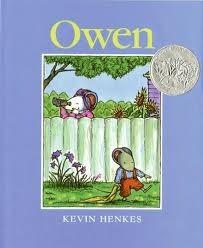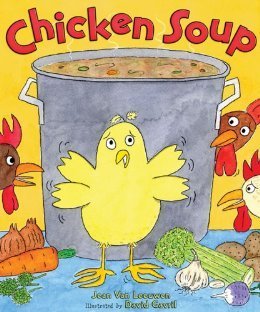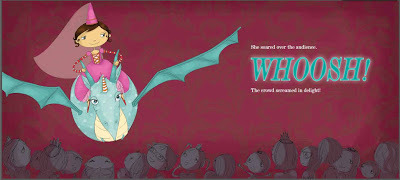Picture Book University: Style Elements

Well, I'm back! Sorry I'm a bit late--we had a household emergency yesterday. That's what happens when you leave for more than a week. :-)
Today, I'm going to be talking about something that can elevate a ho hum manuscript into a publishable piece: Style elements. Now, I won't be going over things you should already know such as using the five senses or metaphors and similes or even voice or POV. Those things should be second nature to you and if they aren't, I'd advise you to take a children's literature course. I talk about different courses on my website here: children's writing.
These style elements are specific to picture books (fiction and nonfiction alike) and it's what sets picture books apart from other types of writing. If you pay attention to placing some of these in your manuscript, you will transform it (and maybe even your creative thinking!) These are not all the elements you could use, but they are the most important to pay attention to, in my opinion.
1. Rhythm--This is usually overlooked in newbie manuscripts. Often, people will write without regard to this
 because, hey! They're not writing a rhyming story. If you look closely at the best books, they will often have a rhythmic line or two within the text. Often, they'll have a bunch. What is rhythm? It's a metered pattern of words. They sound poetic and have a beat. For example, in Kevin Henkes' book, OWEN, he uses a lot of rhythm throughout. After Owen proclaims his blankie, Fuzzy, goes where he goes, Henkes writes where it goes: Upstairs, downstairs, in-between/Inside, outside, up-side-down. Notice it doesn't rhyme, but has a nice beat. On the next page, Henkes describes how the blankie likes what the child likes: Orange juice, grape juice, chocolate milk/Ice cream, peanut butter, applesauce cake. See the rhythm? It's important for your manuscript to have this even if you don't rhyme. I always try to place some rhythm in my manuscripts--fiction or nonfiction.
because, hey! They're not writing a rhyming story. If you look closely at the best books, they will often have a rhythmic line or two within the text. Often, they'll have a bunch. What is rhythm? It's a metered pattern of words. They sound poetic and have a beat. For example, in Kevin Henkes' book, OWEN, he uses a lot of rhythm throughout. After Owen proclaims his blankie, Fuzzy, goes where he goes, Henkes writes where it goes: Upstairs, downstairs, in-between/Inside, outside, up-side-down. Notice it doesn't rhyme, but has a nice beat. On the next page, Henkes describes how the blankie likes what the child likes: Orange juice, grape juice, chocolate milk/Ice cream, peanut butter, applesauce cake. See the rhythm? It's important for your manuscript to have this even if you don't rhyme. I always try to place some rhythm in my manuscripts--fiction or nonfiction. 2. Repetition--This can come in the form of repeated lines, words, or even sentences. It gives a rhythm to your story that's important, but also is fun for a child to say over and over. Children love repetition and that's why after you read a story for the twentieth time, they want it read AGAIN! In CHICKEN SOUP by Jean Van Leeuwen, the story begins with repetition: Pssst! Cow told Sheep. Pssst! Sheep told Pig. Pssst! Pig told Goose. Goose told all the chickens! Pssst! The rest of the book doesn't use this, but it's a great way to open a story. She also uses repetition with onomatopoeia. CLOMP! CLOMP! CLOMP! is used throughout as a repeating line that helps give dramatic tension as the farm animals are all worried the farmer is about to make chicken soup and the chickens are in danger. This repeating line is the sound of the farmer's boots. Children will love to yell this line as a parent or teacher is reading to them. See if you can use this in your manuscript--one repeating phrase or line throughout. We can all remember the line from CLICK CLACK MOO! by Doreen Cronin. It's what made that book famous.
2. Repetition--This can come in the form of repeated lines, words, or even sentences. It gives a rhythm to your story that's important, but also is fun for a child to say over and over. Children love repetition and that's why after you read a story for the twentieth time, they want it read AGAIN! In CHICKEN SOUP by Jean Van Leeuwen, the story begins with repetition: Pssst! Cow told Sheep. Pssst! Sheep told Pig. Pssst! Pig told Goose. Goose told all the chickens! Pssst! The rest of the book doesn't use this, but it's a great way to open a story. She also uses repetition with onomatopoeia. CLOMP! CLOMP! CLOMP! is used throughout as a repeating line that helps give dramatic tension as the farm animals are all worried the farmer is about to make chicken soup and the chickens are in danger. This repeating line is the sound of the farmer's boots. Children will love to yell this line as a parent or teacher is reading to them. See if you can use this in your manuscript--one repeating phrase or line throughout. We can all remember the line from CLICK CLACK MOO! by Doreen Cronin. It's what made that book famous. 3. Puns--this is when you use a word that has a double meaning that's meant to be funny. Editors love puns. Not all manuscripts have them, but if your manuscript has the right tone, a pun can really make your story sparkle and add even more humor. In Dian Curtis Regan's book, BARNYARD SLAM, the use of pun is over-the-top and actually at the center of her story. Every page has some form of pun on it from the ducks being a bunch of quacks all the way to the goose dancing Swan Lake. Many of these puns are only ones adults could understand, but that's okay. Adults are the ones who are buying and reading these stories, so if you have a few puns for the older folks, editors will still like it (but not too much! Always think like a child when writing stories.) I'll never forget a workshop I attended that was taught by an editor from Chronicle. She showed how the manuscript went through 17 revisions and with each revision, they put more and more puns within it. That led to the many puns I put in my manuscripts including PRINCESS PEEPERS and MULTIPLYING MENACE DIVIDES.

4. Circularity--this is where the beginning and ending are either similar or the exactly the same. The story completes a full circle. This can either give closure to the manuscript or even surprise the reader because the
story seems to be starting all over again which will give little ones a reason to read it AGAIN! In Chris Gall's book, THERE'S NOTHING TO DO ON MARS, the book opens as the title suggests, a little boy who lives on Mars is bored--there's nothing to do. Throughout the journey (as this is a journey book), there's TONS to do and yes, he learns something until he ends up on Saturn and guess what? There's nothing to do on Saturn. The ending is full circle--although it's not exactly how it opens, it's very similar (and it could set up a sequel...one never knows!)
5. Onomatopoeia--now I wouldn't put this down if it weren't SOOOO important in picture books. You should have learned about this from 5th grade language class. But I'm going to put it out there that almost every picture book should have some form of this in their story or manuscript (nonfiction, too!!!) Why? Because kids LOVE to say these words and they give sound and vibrancy to a book. Also, it's FUN for the art director to place HUGE text of these sound words within a story. I'll never forget when I put in WHOOSH in PRINCESS PEEPERS PICKS A PET how that one word made such a difference in the page spread. Kids love this.

Assignment 5:
I'd love for you to get your hands on the book ANIMALS DON'T, SO I WON'T by David G. Derrick, Jr. He has almost every element I talked about today and the story is very cute--one you should study. He's a DreamWorks storyboard artist and knows what he's doing to delight children.
For this week:
Check out ten different books, either nonfiction or fiction or both and see if you can spot some of these elements. Are there other elements that the author used to set it apart? Beautiful language, rhyme, alliteration, etc.? Take a look at your work-in-progress. Is there a way you can infuse at least two of these elements within it? Can you try to use all five? See what happens! You might be amazed where these could take your manuscript!If you're new to PBU, check out the first four assignments here: PBU. They don't have to be done in order and there's no set time limit! That's the beauty of a free workshop. It's always here for you.
Please, please, please tell others about this resource if you like it or have learned something new. Just click the twitter birdie or hit the like button below. If you don't want to miss out on a post, just subscribe by email.
Happy writing!
Published on August 08, 2013 10:14
No comments have been added yet.



